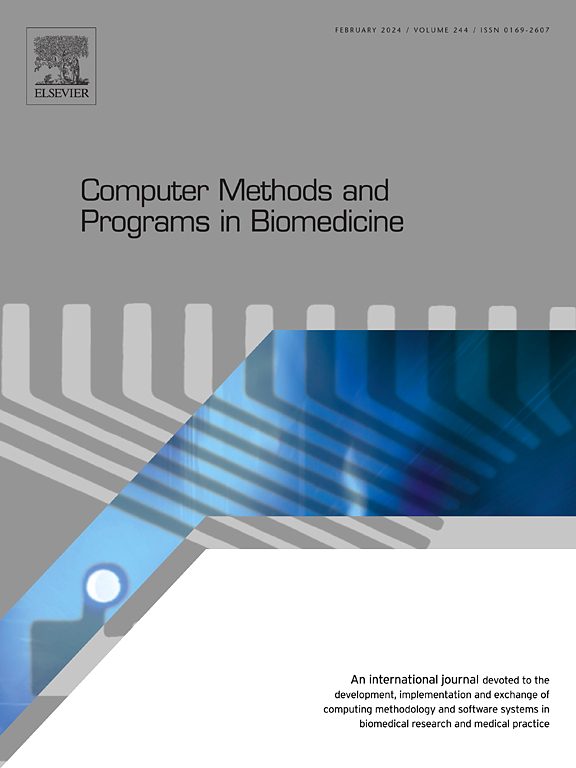晚期胃癌自适应联合治疗方案的药物计量学和数字孪生模型
IF 4.8
2区 医学
Q1 COMPUTER SCIENCE, INTERDISCIPLINARY APPLICATIONS
引用次数: 0
摘要
背景与目的:联合靶向治疗可以显著帮助解决肿瘤生物学异常的动态变化,从而改善反应时间和预后。然而,这些方法的疗效高度依赖于给药之间的组合、相互作用和时间。目前的临床试验只能测试少量具有固定设计的时间表。药物计量学工具可以通过模拟具有不同临床和生物学特征的患者的特征来帮助探索和选择最有效的药物剂量和方案。方法:本研究建立了一个药代动力学-药效学模型,描述了抗血管生成和细胞毒性控制下肿瘤发生和血管生成的网络系统,即Ramucirumab和紫杉醇二线联合治疗。提出了一种两步可扩展算法来校准模型参数并将虚拟与真实人群治疗结果相匹配,然后直接根据无进展生存期(PFS)-2 Kaplan-Meier曲线进行微调。考虑了两个晚期胃癌患者队列:一个来自韩国的校准队列和一个来自IRCCS ' S的外部验证队列。德贝利斯",一家意大利研究医院。这些真实世界的患者具有不同的临床起始条件。我们对新的联合方案进行前瞻性评估,这些方案坚持对临床转化至关重要的药理学限制,其中细胞毒性药物的给药时间由肿瘤微环境数字生物标志物监测的正常化窗口打开触发。结果:校准过程导致发现了一种新的数学生物标志物,描述了肿瘤生长和血管生成对治疗结果的影响。两组PFS-2表现出不同的治疗反应趋势(p值<;0.0001),通过对数秩检验评估预测值。我们的研究结果展示了一种新的方案,通过减少33%的细胞毒性药物,实现了无差别的PFS-2。此外,我们提出了另一种方案,通过使用与标准方案相同的剂量,在121天治疗后将PFS-2从49.2%延长至60.9% (p值<;0.0001)。结论:本研究提出了一个用于虚拟扩展现实世界患者队列的计算机定量平台。此外,对联合治疗的适应性剂量表的疗效估计可以补充和告知临床试验设计。本文章由计算机程序翻译,如有差异,请以英文原文为准。

Pharmacometric and Digital Twin modeling for adaptive scheduling of combination therapy in advanced gastric cancer
Background and Objective:
Combining targeted therapeutics can significantly help address the dynamic changes in cancer biology abnormalities and thus improve the duration of response and outcome. However, the efficacy of such approaches is highly dependent on the combination, interactions, and timing between the administered drugs. Current clinical trials can test only a low number of schedules with fixed designs. Pharmacometric tools can assist in exploring and selecting the most effective drug dosages and schedules by modeling traits of patients with different clinical and biological characteristics.
Methods:
This study proposes a pharmacokinetic–pharmacodynamic model describing the networked system of tumor development and angiogenesis under the control of antiangiogenic and cytotoxic, i.e., Ramucirumab and Paclitaxel second-line combination therapy. A two-step scalable algorithm is proposed to calibrate model parameters and match virtual to real population therapy outcomes, followed by fine-tuning directly on the Progression-free Survival (PFS)-2 Kaplan–Meier curve. Two cohorts of advanced gastric cancer patients were considered: a calibration cohort from South Korea, and an external verification cohort from IRCCS “S. De Bellis”, an Italian research hospital. These real-world patients had heterogeneous clinical starting conditions. We perform prospective evaluations of new combination regimens that adhere to pharmacological constraints that are paramount for clinical translation, in which the administration time of the cytotoxic agent is triggered by the normalization window opening, monitored by a tumor microenvironment digital biomarker.
Results:
The calibration procedure led to the discovery of a new mathematical biomarker describing the influence of intrinsic tumor growth and angiogenesis on treatment outcomes. The predictive value was assessed through the log-rank test between two PFS-2 groups, which exhibited different (-value ) therapy response trends. Our results showcase a new regimen that, by using 33% less cytotoxic drug, achieves indistinguishable PFS-2. Additionally, we present another regimen that extends PFS-2 from 49.2% to 60.9% after 121 days of therapy (-value ), by using the same dosing as the standard protocol.
Conclusions:
This study proposes an in-silico quantitative platform for virtual expansion of real-world patient cohorts. Furthermore, the estimation of the efficacy of adaptive dose schedules of a combined therapy can complement and inform clinical trial design.
求助全文
通过发布文献求助,成功后即可免费获取论文全文。
去求助
来源期刊

Computer methods and programs in biomedicine
工程技术-工程:生物医学
CiteScore
12.30
自引率
6.60%
发文量
601
审稿时长
135 days
期刊介绍:
To encourage the development of formal computing methods, and their application in biomedical research and medical practice, by illustration of fundamental principles in biomedical informatics research; to stimulate basic research into application software design; to report the state of research of biomedical information processing projects; to report new computer methodologies applied in biomedical areas; the eventual distribution of demonstrable software to avoid duplication of effort; to provide a forum for discussion and improvement of existing software; to optimize contact between national organizations and regional user groups by promoting an international exchange of information on formal methods, standards and software in biomedicine.
Computer Methods and Programs in Biomedicine covers computing methodology and software systems derived from computing science for implementation in all aspects of biomedical research and medical practice. It is designed to serve: biochemists; biologists; geneticists; immunologists; neuroscientists; pharmacologists; toxicologists; clinicians; epidemiologists; psychiatrists; psychologists; cardiologists; chemists; (radio)physicists; computer scientists; programmers and systems analysts; biomedical, clinical, electrical and other engineers; teachers of medical informatics and users of educational software.
 求助内容:
求助内容: 应助结果提醒方式:
应助结果提醒方式:


